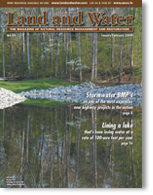Features Available Online
Streams of Success
by Paul Callahan, Mike Rotar, P.E. and Mike DuCuennois, P.E.
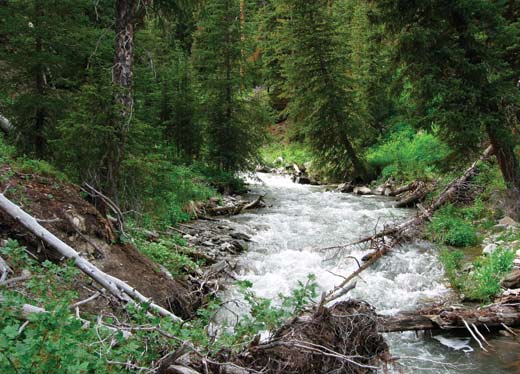
Stream restoration projects have enhanced the natural beauty and rugged wilderness of the Yellowstone Mountian Club. Photo credits: Paul Callahan
Yellowstone Mountain Club near Big Sky, Montana offers residents exclusive ski runs, a designer golf course and acres of mountain beauty. Thanks to environmentally-sensitive upgrades, the resort’s natural streams, and the fish living there, are thriving alongside Yellowstone Club’s human inhabitants.
Forty miles of roadways originally used by the logging industry cut across steep mountain terrain within Yellowstone Club. The Environmental Protection Agency and Montana Fish, Wildlife & Parks listed precise requirements for the development’s road upgrades. At two key stream crossings in particular, regulatory agencies called for significantly reduced flow velocities to minimize scour as well as adequate small mammal passage during low flow conditions.
These two major goals have been achieved with the installation of a bottomless arch pipe with poured concrete footers in both streams. Natural streambed materials and hydraulic characteristics have been maintained or, in some cases, improved. In addition, slower stream velocities allow adult fish to travel upstream in most conditions. Montana Fish, Wildlife & Parks representatives called the design at Yellowstone Club a model for future culvert replacement projects.
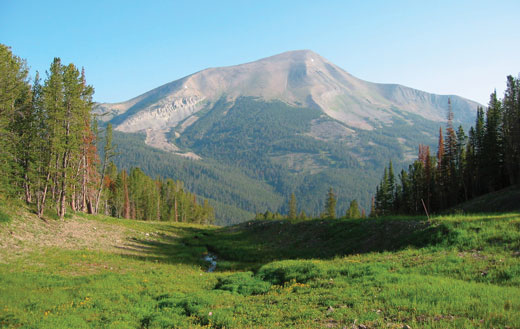
Priority Stream Crossings
Engineers and hydrologists inventoried road drainage structures throughout the Yellowstone Club property. Replacement and upgrade projects were prioritized based on factors including water quality and fisheries concerns.
Topping the upgrade list were two large culverts on sensitive perennial streams: Second Yellow Mule Creek and a tributary to the Gallatin River called the South Fork of the West Fork (South Fork). Westslope Cutthroat Trout, a species of concern in Montana, populate both streams. The crossing at Second Yellow Mule Creek required replacement of approximately 100 feet of 60-inch-diameter corrugated metal pipe. The crossing at the South Fork required replacement of a 72-inch-diameter squashed corrugated metal pipe located upstream of the main Yellowstone Club bridge.
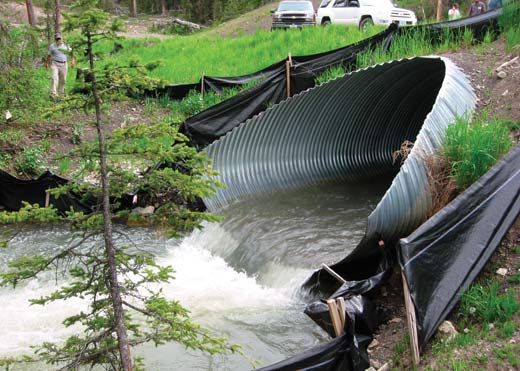
Tough hydraulics: before stream restoration, it was difficult for fish to migrate upstream at this road crossing of the South Fork of the West Fork.
Sensitive Design and Construction
Based on an evaluation of flow velocities and the physical configuration of the site, a 12-foot bottomless arch culvert was selected to replace the existing 60-inch-diameter culvert at Second Yellow Mule Creek. At the creek’s calculated 53 cubic feet per second flow rate, the velocity through the existing culvert was estimated to be 12.5 feet per second (fps). Calculations indicated the stream velocity would be 6.2 fps with the proposed replacement.
The bottomless arch culvert was designed with footers buried two feet below channel grade to avoid scouring effects. PBS&J, an engineering and natural resource consulting firm, provided hydraulic engineering and environmental permitting for the projects along with engineers Mike DuCuennois, Bill Hartsog and Glenn Wood.
For construction of both culvert replacements, engineers elected to work in-stream, maximizing use of mitigation techniques, rather than build a diversion channel. Construction occurred in late fall/winter low flow conditions, and a hydrologist or engineer familiar with sediment mitigation measures oversaw all work. More than 1,000 feet of silt fences minimized sloughing or sidecasting of soil and rock into the channel during excavation. Rock weirs at the culverts’ inlets and outlets helped ensure channel stability around the footers after project completion.
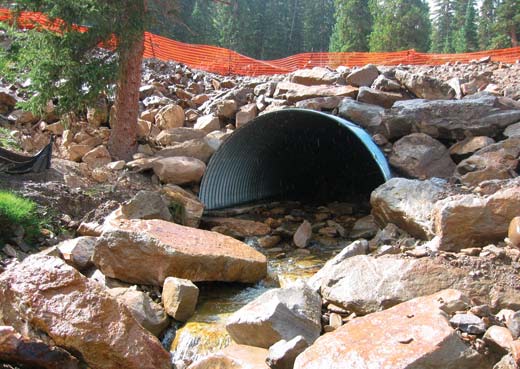
A new “bottomless arch” culvert allows natural streambed materials and hydraulic characteristics to be maintained.
An Eye on Success
Several large boulders were strategically placed at the culverts’ outlets to create a weir. As a result, small spawning-size gravel accumulates at the bottom of the culvert. The boulders do not pose a barrier to upstream migrating fish entering the culvert because they mimic hydraulic conditions found in natural areas of the streams. In fact, the boulders create a slight backwater effect to increase water depth through the culvert and enable upstream passage by younger age-class fish as well. The new culverts also provide sufficiently dry conditions at low flow periods for unimpeded amphibian and small mammal passage.
Since completion of the culvert replacements in December 2004, both stream sites have seen a marked improvement in water velocities, fish habitat and safe passage for local species. Streambed stability, viewed as the remaining challenge, will be monitored for five years. To date, however, channels upstream and downstream of the two creeks have remained stable with no scour observed.
The project has been deemed a success by both developers and regulatory agencies. Development planners working in other sensitive settings can look to the upgrades at Yellowstone Club for inspiration to find their own creative solutions.![]()
For more information, contact Paul Callahan, Senior Hydrologist and Vice President for West Region Environmental Science at PBS&J. He may be reached at (406) 721-0354 or pcallahan@pbsj.com. Mike Rotar, P.E, Senior Hydraulic Engineer in PBS&J’s Bozeman, Montana office. Mike is a lead project manager on stream restoration and fisheries habitat enhancement projects. Mike DuCuennois, P.E., lead development manager and engineer with Yellowstone Mountain Club.

